Page Summary
-
The Google Books API Family includes the Google Books API and the Embedded Viewer API, allowing integration of Google Books features into applications and websites.
-
The Google Books API v1 allows programmatic access to operations like searching for books, viewing book information, and managing bookshelves.
-
The Embedded Viewer API enables embedding book content directly into web pages and controlling it with JavaScript.
-
The APIs are not intended to replace commercial services and are subject to Google's Terms of Service.
The APIs in the Google Books API Family let you bring Google Books features to your site or application. The new Google Books API lets you perform programmatically most of the operations that you can do interactively on the Google Books website. The Embedded Viewer API lets you embed the content directly into your site.
At Google, we're constantly striving to make information available to as many people as possible, and our APIs were designed with that goal in mind. However, we license much of the data that we use to power Google Books, so it's not ours to distribute however we choose.
The API is not intended to be used as a replacement for commercial services. These services are valuable and Google also relies upon them to build our own APIs for the general public.
The Google Terms of Service for use of the APIs is available at https://developer.google.com/books/terms.html. We will suspend a user's access to the APIs if a user violates the Terms of Service and does not take action to remedy the violation after notice of violation by Google.
Books API v1 (Experimental)
The new Google Books API v1 gives you programmatic access to many of the operations available on Google Books website. You can use it to create powerful applications that provide deeper integration with Google Books. Some of the main features that the API provides are:
- search and browse through the list of books that match a given query.
- view information about a book, including metadata, availability and price, links to the preview page.
- manage your own bookshelves.
A good first step in learning about the API is the Getting Started page. It explains the basic concepts that the API uses and describes the basic interaction principles that the API follows. A comprehensive description of all the operations supported by the API is given in the Using the API page.
Embedded Viewer API
|
The Embedded Viewer API lets you embed book content from Google Books directly in your web pages with JavaScript. It allows you to build your own user experience around book previews. Adding book preview functionality to your site is relatively simple, though it does require some knowledge of HTML and JavaScript. The Developer's Guide explains how the API can be loaded using the Google AJAX loader and drawn into a particular container on your page. Once the embedded viewer has been added to a webpage, it can be controlled using JavaScript functions. This allows you to perform actions similar to what the user can do by clicking on the controls: you can go to the next page, zoom in or out, highlight search terms, and so on. You are also able to get the current page number, allowing your code react as the user navigates through the book. |
